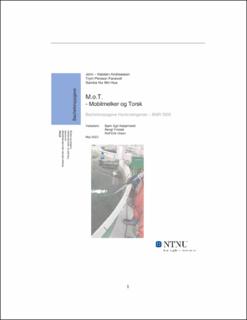| dc.contributor.advisor | Asbjørnslett, Bjørn Egil | |
| dc.contributor.advisor | Finstad, Bengt | |
| dc.contributor.advisor | Olsen, Rolf Erik | |
| dc.contributor.author | Andreassen, John – Halstein | |
| dc.contributor.author | Fanavoll, Trym Persson | |
| dc.contributor.author | Hua, Sandra Hui Min | |
| dc.date.accessioned | 2023-07-08T17:19:13Z | |
| dc.date.available | 2023-07-08T17:19:13Z | |
| dc.date.issued | 2023 | |
| dc.identifier | no.ntnu:inspera:146722289:150145015 | |
| dc.identifier.uri | https://hdl.handle.net/11250/3077336 | |
| dc.description.abstract | Dagens situasjon på ODE sitt gjennomstrømninganlegg for torsk på Stadsbygd gjennomføres røkting av fiskekar ved et hevertsystem. På grunn av lave strømningshastigheter i karene fører dette til oppsamling av partikler på karbunnen.
Oppgavens problemstilling omhandler å teste ut en ny type utstyr (melkemaskin) for å gjennomføre røkteprosessen og sammnenligne det med det tradisjonelle hevertsystemet. Sammenligningsgrunnlaget er faktorer som tidsbruk, fiskevelferd, vannkvalitet og brukervennlighet. Gruppens mål for forsøket er å kartlegge dagens situasjon ved tradisjonell røkting og bruke analysen for videre arbeid. Videre å sammenligne utstyrene basert på faktorer nevnt ovenfor, samt gjennomføre en FMECA av det nye utstyret for å identifisere sviktmoduser.
Resultatene som fremkommer etter å ha gjennomført forsøket var at faktorer som tidsforbruk økte, fiskevelferd ble bedre, vannkvaliteten uforandret, samt at brukevennligheten ble sterkt redusert.
Rapporten konkluderer ved at det nye utstyret per dags dato ikke er en god erstatning som røkteutstyr, men har et stort potensiale ved tilpasninger og forenklinger. | |
| dc.description.abstract | The current situation at the ODE flow-through facility for cod at Stadsbygd involves using a siphon system for fish tank maintenance. However, due to low flow velocities in the tanks, this leads to the accumulation of particles on the tank bottom.
The objective of the task is to test a new type of equipment (milking machine) for conducting the maintenance process and compare it with the traditional siphon system. The basis for comparison includes factors such as time consumption, fish welfare, water quality, and user-friendliness. The group's goal for the experiment is to assess the current situation with traditional maintenance and utilize the analysis for further work. Additionally, they aim to compare the equipment based on the mentioned factors and conduct a Failure Modes, Effects, and Criticality Analysis (FMECA) of the new equipment to identify failure modes.
The results obtained after experimenting indicated that factors such as time consumption increased, fish welfare improved, water quality remained unchanged, and user-friendliness decreased significantly.
The report concludes that the new equipment, as of today, is not a suitable replacement for maintenance equipment but has excellent potential with adjustments and simplifications. | |
| dc.language | nob | |
| dc.publisher | NTNU | |
| dc.title | M.o.T.
Mobilmelker og Torsk | |
| dc.type | Bachelor thesis | |
